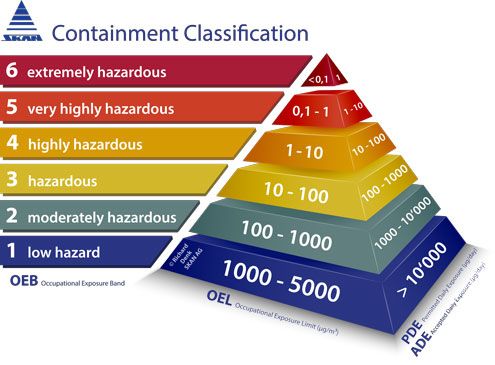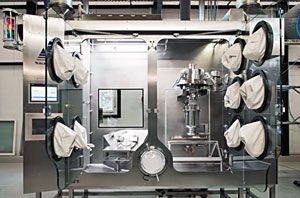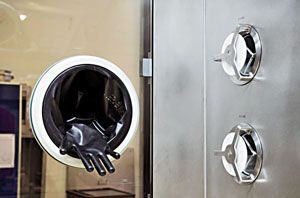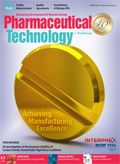Understanding Containment
The new ISPE Containment Manual is a summary of the process involved in the manufacture of highly active or highly hazardous pharmaceutical substances.
The manufacture of highly active or highly hazardous pharmaceutical substances involves a complex interplay between the required threshold values, such as the permitted daily exposure (PDE), which is used to calculate the occupational exposure limit (OEL) and the maximum carry-over from one product to the next. In addition to these threshold values, a risk assessment of the overall process and the associated containment transfer systems, cleaning, and staff training are also important. An account of this complex interplay and how it can be successfully implemented has now been published in the first edition of the International Society for Pharmaceutical Engineering (ISPE) Germany/Austria/Switzerland (D/A/CH) Affiliate's Containment Manual (1).
A group of experts came together in 2008 to establish an ISPE Community of Practice (CoP) in Germany, Switzerland, and Austria, which laid the foundation for a comprehensive document about containment. After almost six years of intensive collaboration, with numerous meetings, working group sessions, workshops, and reviews by industry, the Containment Manual was presented and distributed to participants at the ISPE Containment Workshop in Germany in November 2015.
The Containment Manual is the most comprehensive document to date on the topic of containment, and it comprises an introduction followed by 10 different chapters that cover the principles of containment, risk assessment, the lifecycles of containment solutions, process requirements from API manufacturing to the packaged tablet, technical systems such as isolators, secondary containment, filter systems, occupational hygiene validation, cleaning/waste treatment, and staff training. Selected chapters are outlined in the following.
Principles of containment
How are OELs calculated? The chapter entitled "Fundamental Considerations" focuses on defining the relevant terms. From establishing the critical effect to establishing the no observed effect level (NOEL), which is then used to calculate the acceptable daily exposure (ADE) or, in accordance with the new EU GMP guideline for shared facilities (2), the PDE.
The relationship between the ADE/PDE and the OEL can also be seen in the containment pyramid (see Figure 1). Along with the OEL, the ADE/PDE is used to calculate threshold values for cleaning residues and for product carry-over from one substance to the next. The threshold values calculated using the PDE also replace, in Europe, the 10 ppm and the 1/1000 of the daily dose criteria previously applied (2).
Figure 1. The containment classification pyramid compares occupational exposure limit (OEL), occupational exposure band (OEB), permitted daily exposure (PDE), and accepted daily exposure (ADE). ADCs require OELs of <0.1 μg/ m3. Images are courtesy of the author.

A further point relating to the principles of containment is the distinction between primary and secondary containment. Primary containment refers to all of those technologies that enclose the substance and prevent it from spreading. Examples of this include isolators and endless liner systems. Secondary containment, on the other hand, involves preventing any further spreading of the substance that could not be held back through primary containment.
Risk assessment
Every planning process begins with a risk assessment, which takes the overall manufacturing process into account, from delivery of the API to the finished and packaged pharmaceutical product. The procedure involves assessing the risks that may arise and the extent of the immediate hazard for users and the environment. In addition to the immediate hazard associated with product transfer systems, cleaning, maintenance, and repair should also be taken into account. During cleaning, for example, it must be noted that dust exposure is possible when opening containment or process systems at critical points. Maintenance work, for its part, involves the risk of visible product deposits being left on shaft seals when parts are disassembled, for example. As part of the risk assessment, all experienced individuals who are familiar with the manufacturing process should sit together with suppliers to discuss critical areas, risk reduction, and risk acceptance.
The lifecycle of containment solutions
The lifecycle of a containment installation does not end when it goes into operation-it is only just beginning. More precisely, the lifecycle starts with the planning process for manufacturing a highly active or highly hazardous pharmaceutical product, together with its specifications, and ends with decommissioning. There may be a significant period of time in between, during which the containment installation and its safety function will need to keep pace with the relevant requirements. One of the most significant factors for ensuring compliance is maintenance and repair. Consumables used in pharmaceutical manufacturing are subject to a constant process of wear, and this wear can vary according to process, frequency, and product. Based on these requirements, it can be necessary to shorten the inspection and maintenance intervals. Ideally, the OEL measured on the installation (referred to as the DEL, or "design exposure limit") should be significantly below the required OEL. It is, in any case, essential to note the point in time at which the first effect level is reached, or alternatively to ensure that this does not occur. The first effect level is reached when the DEL becomes very close to the required OEL. Maintenance plans and instructions help to secure the lifecycle of the containment.
Process requirements
As a rule, the processes involved in API manufacturing or pharmaceutical formulation are considered to be closed and hence safe. There are, however, several important points to take into account when it comes to planning functioning process containment. One of these is product residue, as shown in the following example.
A high shear mixer is a process device that is closed while the product being manufactured is processed. It must be noted, however, that this technology is not completely self-emptying. It may be necessary to open the system to remove (potentially expensive) product residues from surfaces and make them available for further processing. These systems also have shaft feedthroughs from the exterior to the interior, and these feedthroughs are subject to wear, even when equipped with the best seals and air flushing. In particular, when the product is abrasive and friction against the seal is intensified by the rotation of the mixing paddle, product may be carried over into the seal. Inerting with a noble gas can also result in residue. Flushing the gas with low pressure can result in air turbulence at the point where the gas enters into the process, making it possible for product dust to be deposited in the gas pipe against the direction of flow.
Technical systems
In addition to describing the functions of the individual process systems, the Containment Manual also lists the possible technical containment systems that can be used for this process together with the critical areas to be considered in each case. The term "containment" primarily refers to product transfer systems such as isolators. These technical systems are intended to ensure that highly active or highly hazardous substances do not escape. Further product transfer systems include double valve systems, film connection systems, endless liner systems, rapid transfer ports (RTPs), film isolators, and various others. All of these systems have their merits and are used in the pharmaceutical manufacturing of highly active or highly hazardous substances.
Figure 2: Aseptic powder isolator designed for low nanogram-range occupational exposure limit requirements.

Isolators are undoubtedly the most frequently used form of containment system. They can be put to various different uses and can achieve a high level of containment down to the low nanogram range. Achieving this result in the low nanogram range, however, needs a significant amount of experience in isolator manufacture and design. Here, the glove port design and glass door seals also play an important role, in addition to hygienic design. Figure 2 shows an example of an isolator with high containment.
The filter technology used for inlet and outlet air is a further important factor. In many cases, bag in/bag out or push–push systems are used. With bag in/bag out systems, the low nanogram range cannot be reached due to technical limitations. While this is possible with push–push filters, they are a concern from a GMP perspective, as they involve pushing the contaminated filter cartridge into the cleaned isolator. However carefully this procedure is carried out, the risk of contamination within the isolator cannot be ruled out, nor can the risk of contaminating the new filter.
Figure 3: Isolated filter cartridges (FiPa) connected and opened.

Isolated filter cartridges called “FiPa” are the better option in this regard. The FiPa, shown in Figure 3, is constructed in a similar way to the isolator itself; it is completely sealed before use and is connected to the isolator in this state. Once the FiPa has been connected, the cover plate is opened from the outside into the isolator so that the contaminated air flows inwards and the dust is collected. Before the isolator is cleaned, the cover plate is closed to seal the highly active or highly hazardous substance within the filter housing. The FiPa is disconnected and disposed of once the cleaning process is complete. Sophisticated technical solutions are required to ensure that the low nanogram range can be reached in a secure installation.
Personnel
An essential factor in the success of a containment installation is the production team that operates the facility once it has been successfully commissioned. The production team should be selected at the early stages of planning and integrated into the decision-making process. Intensive and recurring training during commissioning and the initial stages of routine production is significant when it comes to complying with the required OEL.
Conclusion
The development and manufacture of highly active substances are becoming increasingly common. While in the past, these were primarily APIs and products in the pharmaceutical manufacturing of oral solid dosages, they are now also being used increasingly in biotech, such as in antibody drug conjugates. The Containment Manual will support those planning a new, high-potency API facility or modernizing an existing production facility.
References
1. ISPE Germany/Austria/Switzerland (D/A/CH) Affiliate, Containment Manual (ISPE D/A/CH Affiliate, November 2015).
2. EMA, Guideline on Setting Health-Based Exposure Limits for Use in Risk Identification in the Manufacture of Different Medicinal Products in Shared Facilities (EMA, Nov. 20, 2014).
About the Author
Richard Denk is head of the Containment Group at SKAN AG, richard.denk@skan.ch.
Article Information
Pharmaceutical Technology
Vol. 41, No. 3
Pages: 80–83
Citation:
When referring to this article, please cite it as R. Denk, "Understanding Containment," Pharmaceutical Technology 41 (3) 2017.

Drug Solutions Podcast: Applying Appropriate Analytics to Drug Development
March 26th 2024In this episode of the Drug Solutions Podcast, Jan Bekker, Vice President of Business Development, Commercial and Technical Operations at BioCina, discusses the latest analytical tools and their applications in the drug development market.
Legal and Regulatory Perspectives on 3D Printing: Drug Compounding Applications
December 10th 2024This paper explores the legal and regulatory framework around 3D drug printing, particularly for personalized medicine, considering regulatory compliance, business concerns, and intellectual property rights.